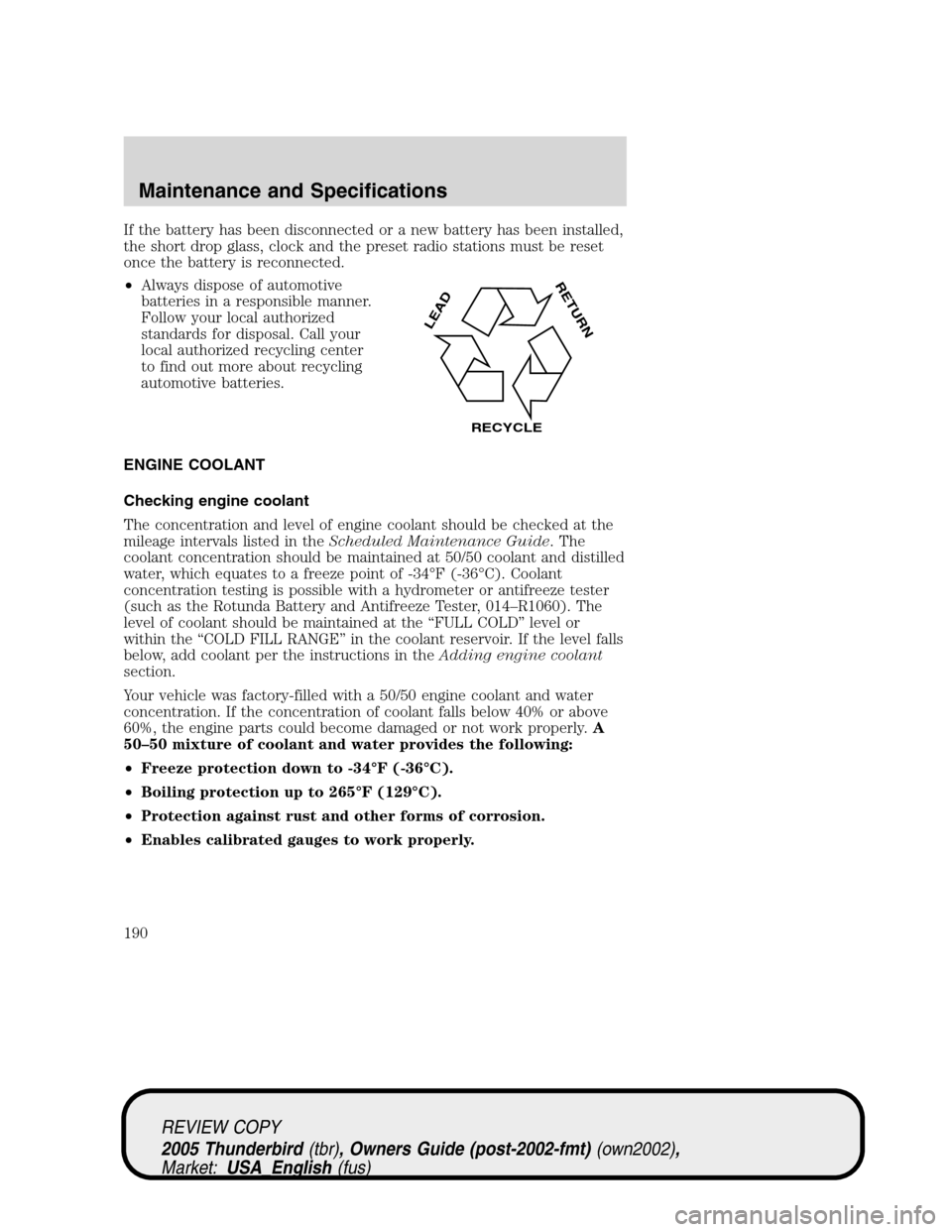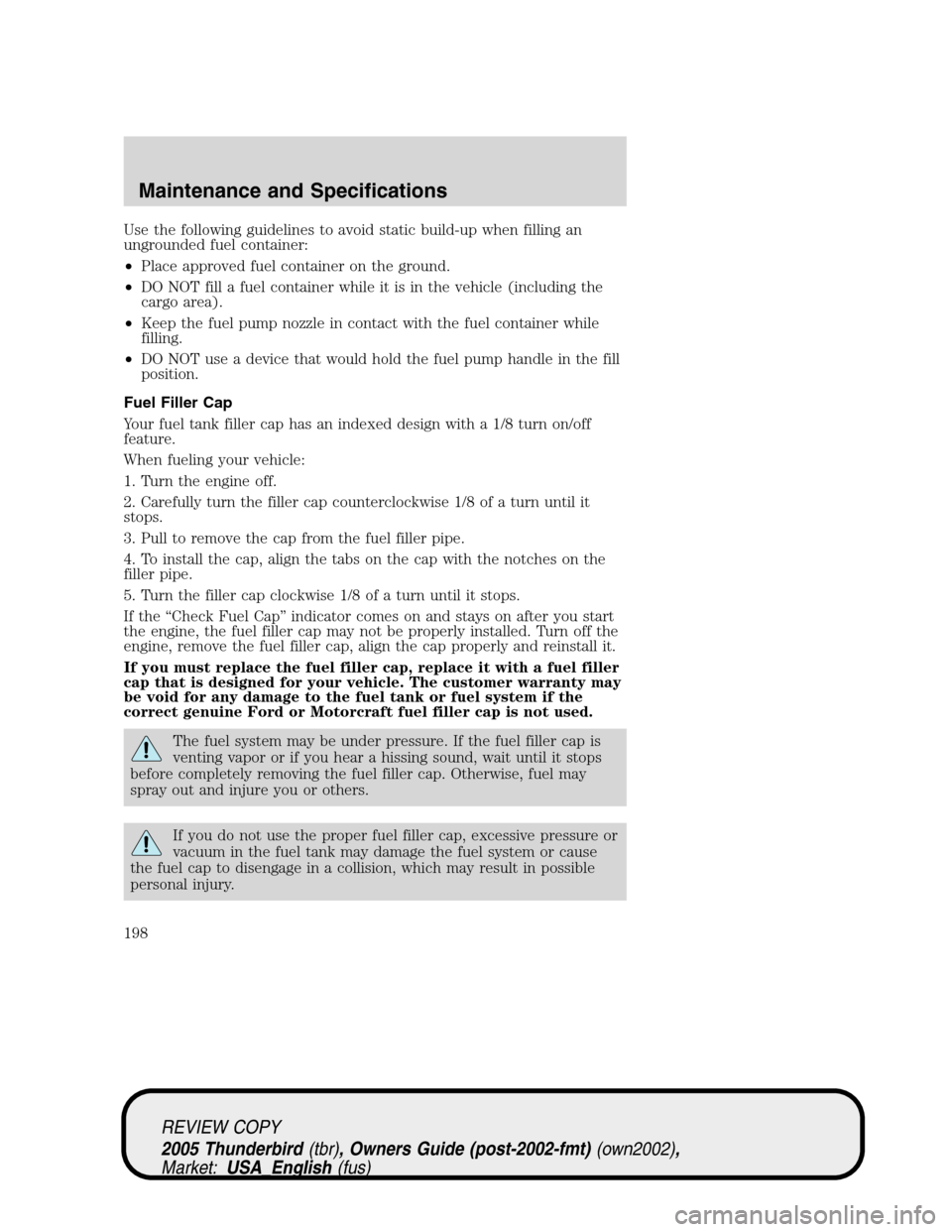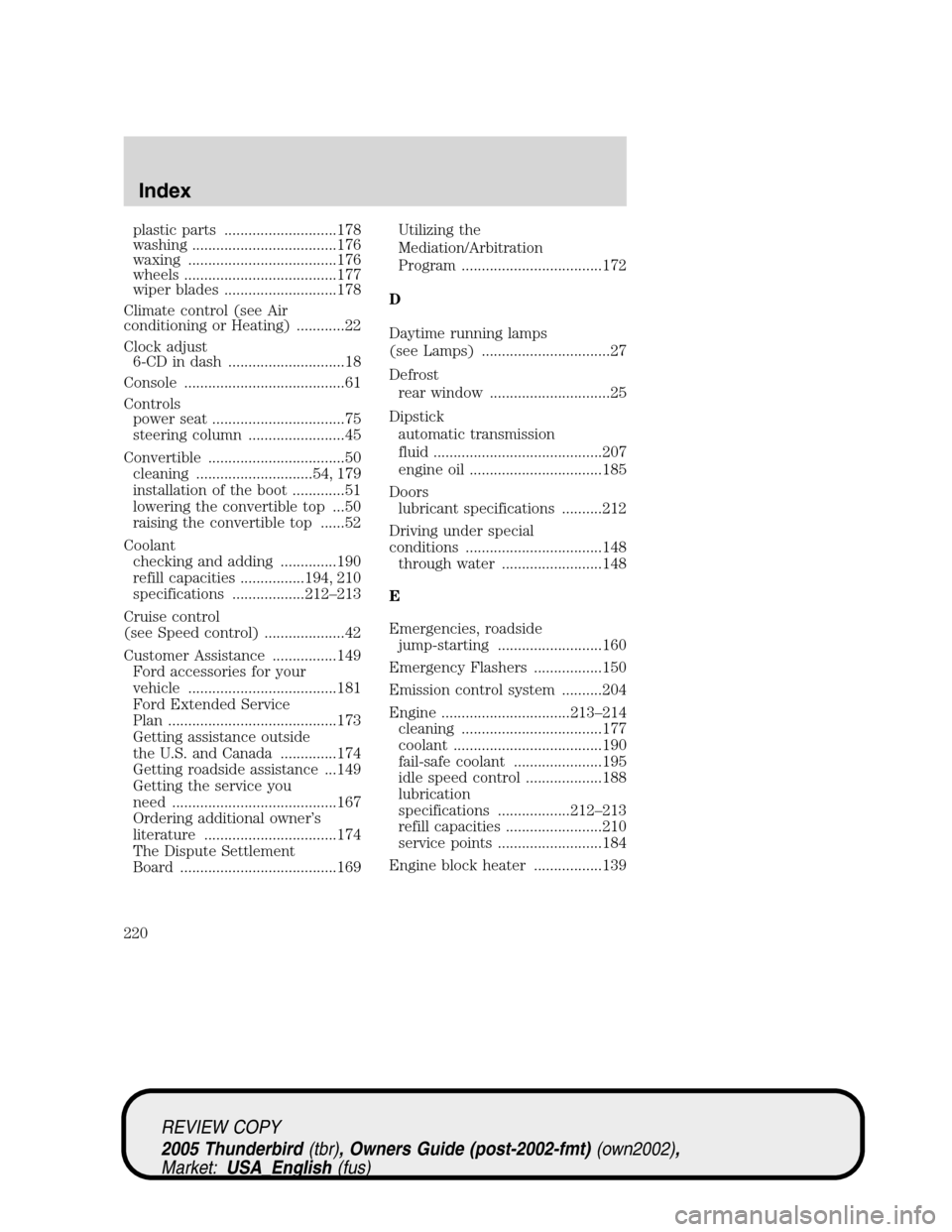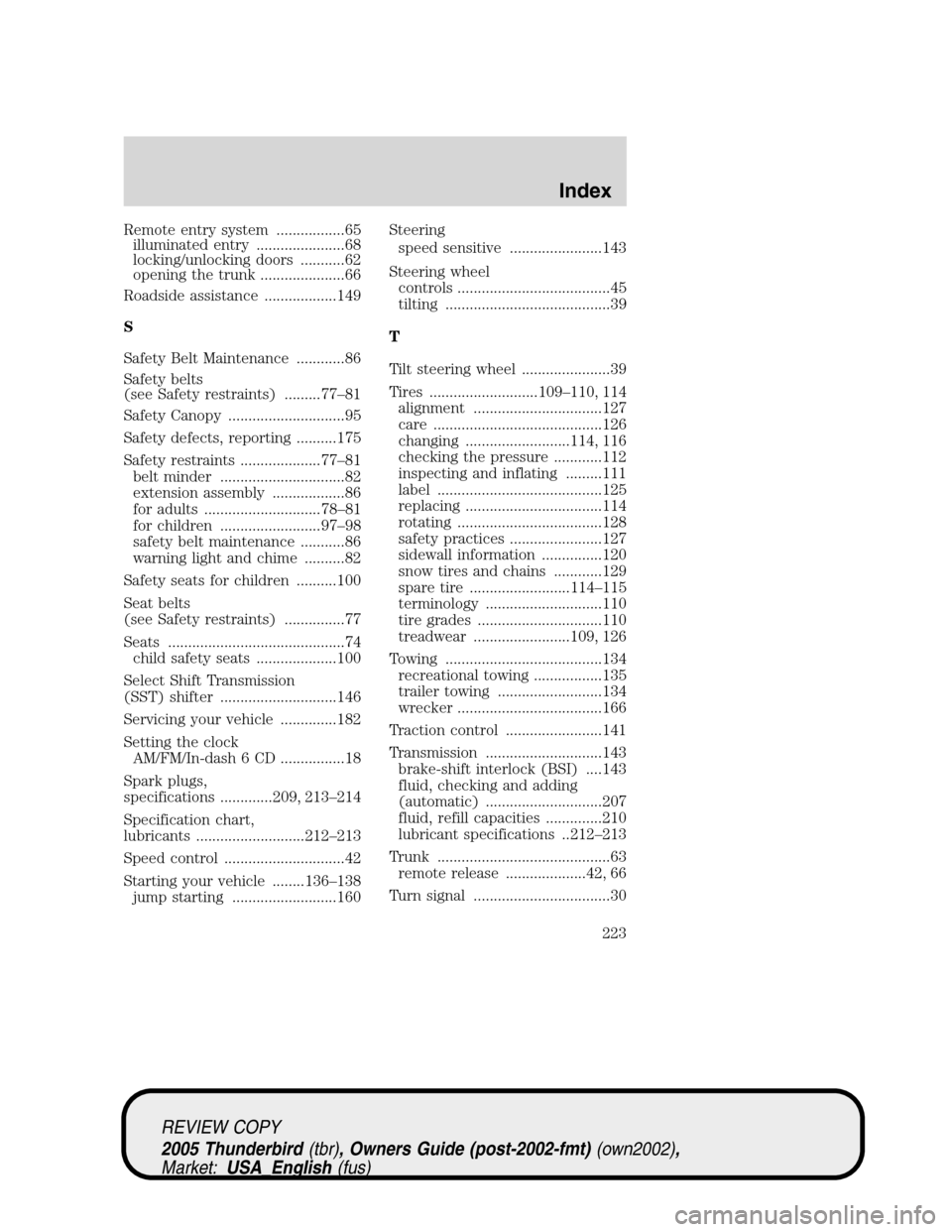clock FORD THUNDERBIRD 2005 11.G User Guide
[x] Cancel search | Manufacturer: FORD, Model Year: 2005, Model line: THUNDERBIRD, Model: FORD THUNDERBIRD 2005 11.GPages: 224, PDF Size: 1.91 MB
Page 187 of 224

3. Recheck the engine oil level. Make sure the oil level is not above the
MAX mark on the engine oil level indicator (dipstick).
4. Install the indicator and ensure it is fully seated.
5. Fully install the engine oil filler cap by turning the filler cap clockwise
tightly until clicks are heard, or until it is snug.
To avoid possible oil loss, DO NOT operate the vehicle with the
engine oil level indicator and/or the engine oil filler cap removed.
Engine oil and filter recommendations
Look for this certification
trademark.
Use SAE 5W-20 engine oil.
Only use oils“Certified For Gasoline Engines”by the American
Petroleum Institute (API). An oil with this trademark symbol conforms
to the current engine and emission system protection standards and fuel
economy requirements of the International Lubricant Standardization and
Approval Committee (ISLAC), comprised of U.S. and Japanese
automobile manufacturers.
To protect your engine’s warranty use Motorcraft SAE 5W-20 or an
equivalent 5W-20 oil meeting Ford specification WSS-M2C930-A.SAE
5W-20 oil provides optimum fuel economy and durability
performance meeting all requirements for your vehicle’s engine.
Do not use supplemental engine oil additives, cleaners or other engine
treatments. They are unnecessary and could lead to engine damage that
is not covered by Ford warranty.
Change your engine oil according to the appropriate schedule listed in
the scheduled maintenance guide.
Ford production and aftermarket (Motorcraft) oil filters are designed for
added engine protection and long life. If a replacement oil filter is used
that does not meet Ford material and design specifications, start-up
engine noises or knock may be experienced.
REVIEW COPY
2005 Thunderbird(tbr), Owners Guide (post-2002-fmt)(own2002),
Market:USA_English(fus)
Maintenance and Specifications
187
Page 190 of 224

If the battery has been disconnected or a new battery has been installed,
the short drop glass, clock and the preset radio stations must be reset
once the battery is reconnected.
•Always dispose of automotive
batteries in a responsible manner.
Follow your local authorized
standards for disposal. Call your
local authorized recycling center
to find out more about recycling
automotive batteries.
ENGINE COOLANT
Checking engine coolant
The concentration and level of engine coolant should be checked at the
mileage intervals listed in theScheduled Maintenance Guide. The
coolant concentration should be maintained at 50/50 coolant and distilled
water, which equates to a freeze point of -34°F (-36°C). Coolant
concentration testing is possible with a hydrometer or antifreeze tester
(such as the Rotunda Battery and Antifreeze Tester, 014–R1060). The
level of coolant should be maintained at the“FULL COLD”level or
within the“COLD FILL RANGE”in the coolant reservoir. If the level falls
below, add coolant per the instructions in theAdding engine coolant
section.
Your vehicle was factory-filled with a 50/50 engine coolant and water
concentration. If the concentration of coolant falls below 40% or above
60%, the engine parts could become damaged or not work properly.A
50–50 mixture of coolant and water provides the following:
•Freeze protection down to -34°F (-36°C).
•Boiling protection up to 265°F (129°C).
•Protection against rust and other forms of corrosion.
•Enables calibrated gauges to work properly.
LEAD
RETURN
RECYCLE
REVIEW COPY
2005 Thunderbird(tbr), Owners Guide (post-2002-fmt)(own2002),
Market:USA_English(fus)
Maintenance and Specifications
190
Page 193 of 224

remove the coolant pressure relief cap on the radiator of a vehicle with
an overflow system, follow these steps to add engine coolant.
To reduce the risk of personal injury, make sure the engine is
cool before unscrewing the coolant pressure relief cap. The
cooling system is under pressure; steam and hot liquid can come out
forcefully when the cap is loosened slightly.
1. Before you begin, turn the engine off and let it cool.
2. When the engine is cool, wrap a thick cloth around the coolant
pressure relief cap on the coolant reservoir (a translucent plastic bottle).
Slowly turn cap counterclockwise (left) until pressure begins to release.
3. Step back while the pressure releases.
4. When you are sure that all the pressure has been released, use the
cloth to turn it counterclockwise and remove the cap.
5. Fill the coolant reservoir slowly with the proper coolant mixture (see
above), to within the“COLD FILL RANGE”or the“FULL COLD”level on
the reservoir. If you removed the radiator cap in an overflow system, fill
the radiator until the coolant is visible and radiator is almost full.
6. Replace the cap. Turn until tightly installed. (Cap must be tightly
installed to prevent coolant loss.)
After any coolant has been added, check the coolant concentration (refer
toChecking engine coolant). If the concentration is not 50/50
(protection to–34°F/–36°C), drain some coolant and adjust the
concentration. It may take several drains and additions to obtain a 50/50
coolant concentration.
Whenever coolant has been added, the coolant level in the coolant
reservoir should be checked the next few times you drive the vehicle. If
necessary, add enough 50/50 concentration of engine coolant and
distilled water to bring the liquid level to the proper level.
If you have to add more than 1.0 quart (1.0 liter) of engine coolant per
month, have your dealer check the engine cooling system. Your cooling
system may have a leak. Operating an engine with a low level of coolant
can result in engine overheating and possible engine damage.
Recycled engine coolant
Ford Motor Company does NOT recommend the use of recycled engine
coolant in vehicles originally equipped with Motorcraft Premium Gold
Engine Coolant since a Ford-approved recycling process is not yet
available.
REVIEW COPY
2005 Thunderbird(tbr), Owners Guide (post-2002-fmt)(own2002),
Market:USA_English(fus)
Maintenance and Specifications
193
Page 198 of 224

Use the following guidelines to avoid static build-up when filling an
ungrounded fuel container:
•Place approved fuel container on the ground.
•DO NOT fill a fuel container while it is in the vehicle (including the
cargo area).
•Keep the fuel pump nozzle in contact with the fuel container while
filling.
•DO NOT use a device that would hold the fuel pump handle in the fill
position.
Fuel Filler Cap
Your fuel tank filler cap has an indexed design with a 1/8 turn on/off
feature.
When fueling your vehicle:
1. Turn the engine off.
2. Carefully turn the filler cap counterclockwise 1/8 of a turn until it
stops.
3. Pull to remove the cap from the fuel filler pipe.
4. To install the cap, align the tabs on the cap with the notches on the
filler pipe.
5. Turn the filler cap clockwise 1/8 of a turn until it stops.
If the“Check Fuel Cap”indicator comes on and stays on after you start
the engine, the fuel filler cap may not be properly installed. Turn off the
engine, remove the fuel filler cap, align the cap properly and reinstall it.
If you must replace the fuel filler cap, replace it with a fuel filler
cap that is designed for your vehicle. The customer warranty may
be void for any damage to the fuel tank or fuel system if the
correct genuine Ford or Motorcraft fuel filler cap is not used.
The fuel system may be under pressure. If the fuel filler cap is
venting vapor or if you hear a hissing sound, wait until it stops
before completely removing the fuel filler cap. Otherwise, fuel may
spray out and injure you or others.
If you do not use the proper fuel filler cap, excessive pressure or
vacuum in the fuel tank may damage the fuel system or cause
the fuel cap to disengage in a collision, which may result in possible
personal injury.
REVIEW COPY
2005 Thunderbird(tbr), Owners Guide (post-2002-fmt)(own2002),
Market:USA_English(fus)
Maintenance and Specifications
198
Page 220 of 224

plastic parts ............................178
washing ....................................176
waxing .....................................176
wheels ......................................177
wiper blades ............................178
Climate control (see Air
conditioning or Heating) ............22
Clock adjust
6-CD in dash .............................18
Console ........................................61
Controls
power seat .................................75
steering column ........................45
Convertible ..................................50
cleaning .............................54, 179
installation of the boot .............51
lowering the convertible top ...50
raising the convertible top ......52
Coolant
checking and adding ..............190
refill capacities ................194, 210
specifications ..................212–213
Cruise control
(see Speed control) ....................42
Customer Assistance ................149
Ford accessories for your
vehicle .....................................181
Ford Extended Service
Plan ..........................................173
Getting assistance outside
the U.S. and Canada ..............174
Getting roadside assistance ...149
Getting the service you
need .........................................167
Ordering additional owner’s
literature .................................174
The Dispute Settlement
Board .......................................169Utilizing the
Mediation/Arbitration
Program ...................................172
D
Daytime running lamps
(see Lamps) ................................27
Defrost
rear window ..............................25
Dipstick
automatic transmission
fluid ..........................................207
engine oil .................................185
Doors
lubricant specifications ..........212
Driving under special
conditions ..................................148
through water .........................148
E
Emergencies, roadside
jump-starting ..........................160
Emergency Flashers .................150
Emission control system ..........204
Engine ................................213–214
cleaning ...................................177
coolant .....................................190
fail-safe coolant ......................195
idle speed control ...................188
lubrication
specifications ..................212–213
refill capacities ........................210
service points ..........................184
Engine block heater .................139
REVIEW COPY
2005 Thunderbird(tbr), Owners Guide (post-2002-fmt)(own2002),
Market:USA_English(fus)
Index
220
Page 223 of 224

Remote entry system .................65
illuminated entry ......................68
locking/unlocking doors ...........62
opening the trunk .....................66
Roadside assistance ..................149
S
Safety Belt Maintenance ............86
Safety belts
(see Safety restraints) .........77–81
Safety Canopy .............................95
Safety defects, reporting ..........175
Safety restraints ....................77–81
belt minder ...............................82
extension assembly ..................86
for adults .............................78–81
for children .........................97–98
safety belt maintenance ...........86
warning light and chime ..........82
Safety seats for children ..........100
Seat belts
(see Safety restraints) ...............77
Seats ............................................74
child safety seats ....................100
Select Shift Transmission
(SST) shifter .............................146
Servicing your vehicle ..............182
Setting the clock
AM/FM/In-dash 6 CD ................18
Spark plugs,
specifications .............209, 213–214
Specification chart,
lubricants ...........................212–213
Speed control ..............................42
Starting your vehicle ........136–138
jump starting ..........................160Steering
speed sensitive .......................143
Steering wheel
controls ......................................45
tilting .........................................39
T
Tilt steering wheel ......................39
Tires ...........................109–110, 114
alignment ................................127
care ..........................................126
changing ..........................114, 116
checking the pressure ............112
inspecting and inflating .........111
label .........................................125
replacing ..................................114
rotating ....................................128
safety practices .......................127
sidewall information ...............120
snow tires and chains ............129
spare tire .........................114–115
terminology .............................110
tire grades ...............................110
treadwear ........................109, 126
Towing .......................................134
recreational towing .................135
trailer towing ..........................134
wrecker ....................................166
Traction control ........................141
Transmission .............................143
brake-shift interlock (BSI) ....143
fluid, checking and adding
(automatic) .............................207
fluid, refill capacities ..............210
lubricant specifications ..212–213
Trunk ...........................................63
remote release ....................42, 66
Turn signal ..................................30
REVIEW COPY
2005 Thunderbird(tbr), Owners Guide (post-2002-fmt)(own2002),
Market:USA_English(fus)
Index
223